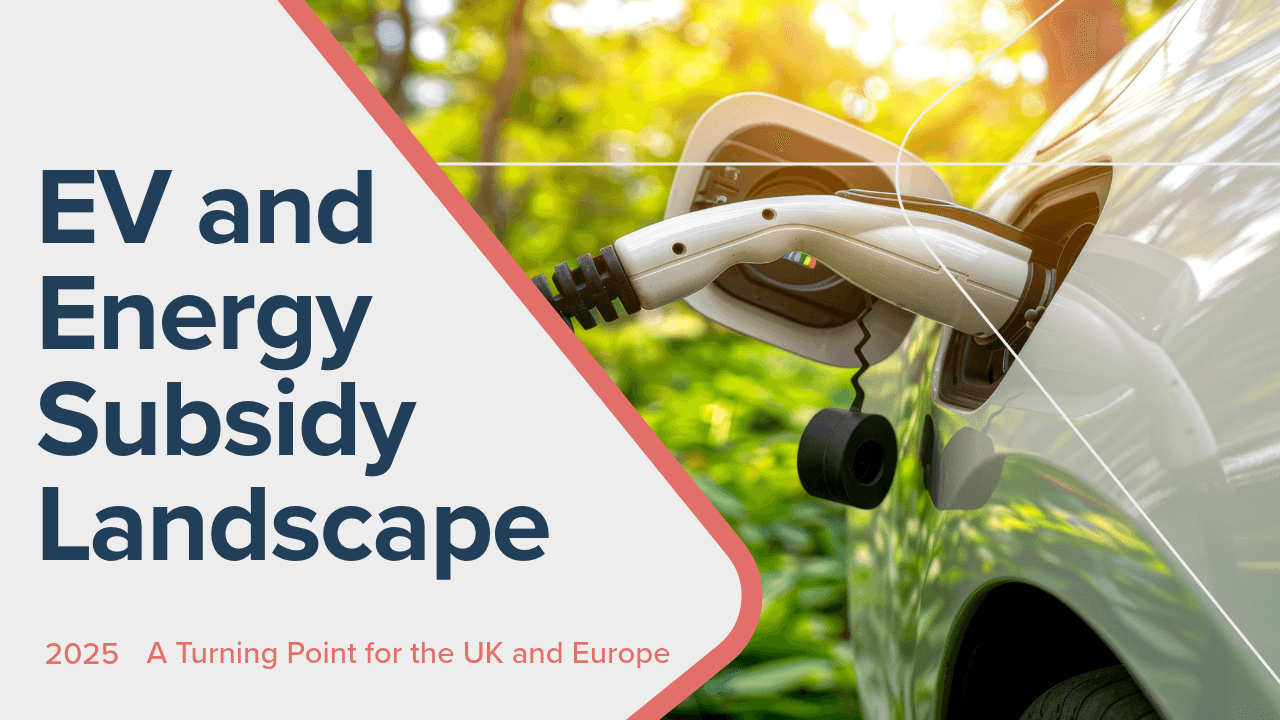EV and Energy Subsidy Landscape 2025
Sep 25, 2025·By Larkspur International
This report provides a comprehensive overview of the most recent and impactful electric vehicle (EV) and energy subsidy programmes in the United Kingdom and across Europe. It highlights recent policy changes, strategic funding opportunities, and the implications for buyers, fleets, and infrastructure developers.

Key findings include:
- The UK has reintroduced a national EV grant programme in July 2025, worth £650m, offering up to £3,750 for qualifying vehicles.
- EU-level climate and infrastructure packages continue to underpin national subsidies and charging deployment.
- Major markets such as Germany, France, and Spain have seen important shifts in subsidy availability, with Germany moving toward tax incentives, France restructuring its ecological bonus, and Spain continuing the MOVES scheme.
- Subsidy availability is often budget-limited and region-specific, requiring close monitoring for timely applications.
United Kingdom: EV Subsidy Landscape
1. Reintroduced EV Purchase Grant (July 2025):
- A £650 million scheme offers up to £3,750 off new battery-electric vehicles (BEVs) priced below ~£37,000.
- This represents a significant policy reversal, reinstating direct purchase incentives after their 2022 removal.
2. Charging Infrastructure Grants:
- Home and renter/flat-owner ChargePoint grants continue.
- The Depot Charging Scheme provides up to 75% of costs for commercial fleet charging infrastructure.
- On-street residential schemes remain active via local authorities.
3. Tax Incentives and Salary Sacrifice:
- Company car tax (benefit-in-kind) rates remain very favourable for EVs.
- Salary sacrifice schemes increase affordability through payroll tax efficiencies.
European Union: Policy and Funding Frameworks
At the EU level, several overarching frameworks shape national subsidy regimes:
- Fit for 55: Establishes emissions reduction pathways, including road transport.
- Alternative Fuels Infrastructure Regulation (AFIR): Mandates charging station density across TEN-T corridors.
- EU Funds: Connecting Europe Facility (CEF), Recovery and Resilience Facility, and cohesion funds finance charging and energy infrastructure projects.
Key National Programmes in Europe
Germany
- The Umwelt bonus purchase subsidy has been phased out as of late 2023.
- Support now centres on tax relief, including reduced company car tax and accelerated depreciation.
- Proposals for new targeted incentives are under discussion but constrained by fiscal limits.
France
- The “bonus écologique” was restructured in July 2025, shifting support toward energy efficiency and conversion schemes.
- The “prime à la conversion” remains available, supporting trade-in of older vehicles for low-emission models.
- Infrastructure funding continues alongside national green industrial policies.
Spain
- The MOVES III programme continues into 2025 with a €400 million budget.
- Subsidies support both EV purchases and charging infrastructure installation.
- Availability depends on regional budgets, with some autonomous communities already exhausting allocations.
Strategic Implications
For Buyers:
- Substantial savings remain possible, especially in the UK, Spain, and select EU countries.
- Monitoring scheme eligibility and budget windows is critical.
For Fleets and Infrastructure Developers:
- Depot and workplace charging grants provide significant cost offsets.
- EU and national funding streams can support large-scale deployment projects.
For Investors:
- Policy volatility (e.g., Germany’s subsidy withdrawal, France’s restructuring) underscores the need for adaptive strategies.
- Long-term tax incentives remain more stable than purchase grants.
